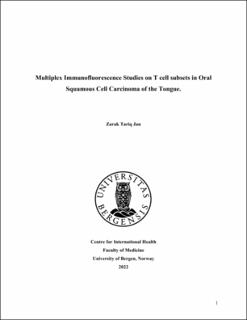| dc.description.abstract | Background: Cancer of the oral cavity is a common malignancy, notably in low-middle income countries (LMIC). Almost half of the cases of oral cancer appear in the tongue (41.5%). Oral Squamous cell carcinoma (OSCC) is the major histology, and the most common etiological factors are excessive tobacco and alcohol usage. Even after successful intervention and treatment, almost 50% of OSCC patients pass away within 5 years. Globally, there was an incidence of 377,713 new cases in 2020, most notable in South Asian populations. The immune system performs a critical function in eliminating cancers. Tumor-infiltrating T cells have been demonstrated to relate to overall survival and reaction to the treatment of OSCC. In particular, memory-resident cytotoxic T cells are reported as crucial to a successful immune response against tumors, spontaneously but also in the context of immunotherapy. Objective: The main objective of the present study was to assess the prognostic value of tumor-infiltrating cytotoxic and memory T cells in OSCC of the tongue and establish a protocol for sequential staining of markers defining this T cell subset in OSCCT tissue samples and determine the amount of and prognostic value of these cells in OSCC of the tongue when analyzed against patient clinical and pathological data. Methods: TMAs obtained from 123 cases of tongue OSCC part of the NOROC cohort were tested in this study. A protocol for multiplexing immunofluorescence was devised. The TMAs were tested for CD8+, CD103+, CD45RO+, CD3+, KI67+, Granzyme B+, markers for T cells, and Pan Cytokeratin+ to identify malignant epithelia. The targeted antigens were visualized using an Olympus VS120 S6 Slide scanner. QuPath software was used for image analysis, and we started the study with the quantification of CD8+, CD103+, and CD8+CD103+ cells. Statistical analysis of the data was achieved using IBM SPSS 27 statistical analysis software. Results: We were able to devise a successful protocol for multiplexed staining. We were able to quantify and analyze the TILs we wanted to visualize. Most of the patients were above 50 years of age, and overall survival for all stages was 56.8%. Almost half of the patients were diagnosed with TNM stage III. There was recurrency regionally in 22.6% of patients, and it was distant in 6.4% of patients. There was high survival with patients having early TNM stage (stage I and II), no perineural thickness in tumors less < than 8 mm, depth of invasion < 5 mm, and no recurrent metastasis. A high number of CD8+ cells was associated with tumors that had poor differentiation, low keratinization but low nuclear polymorphism, and low local recurrence. A high number of CD103+ cells were associated with high keratinization, lower tumor stage, and no local recurrence. Double positive CD8+CD103+ cells were higher in number in low nuclear polymorphism and low regional recurrence. The amount of CD8+, CD103+, and CD8+CD103+ frequency had no impact on overall survival. Conclusion: The protocol for multiplex staining we devised is suitable for sequential staining of TMAs from cancer tissues. This is useful since it permits staining the same cells for several markers maintaining the tissue morphology and with minimal bleeding of the signal. Even if we analyzed only T cell markers so far, results show that the expression of CD8 and CD103 in tumor infiltrates could be of prognostic value in OSCCT. This study can be a significant contribution to the knowledge of the significance of immune response in OSCCT and we look forward to better understanding the significance of the T cell subsets and exploring further the meaning and expression of CD103 in tumor infiltrates. | |
